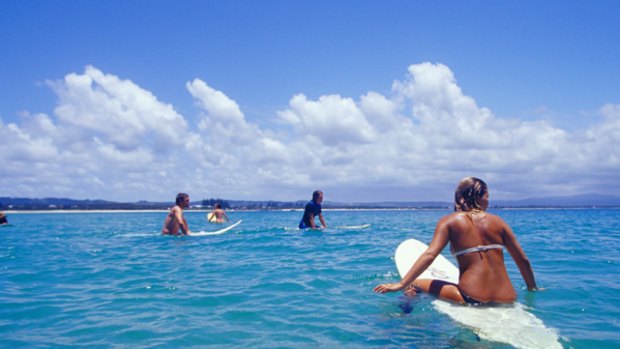
Surfers wait for the waves in Byron BayCredit: Andrew Quilty
I have a back catalogue of Byron Bay experiences, the most radical of which occurred on what I now refer to as the head-shaving holiday. It began a matter of days after year 12 exams concluded. My excitable travelling party settled at a backpackers place, signed up to a drinking "game" and ended with me returning home minus my schoolgirl ponytail.
Several years later I returned, though this time for less dancing and more romancing, on a road trip with an erstwhile love. And there was a fleeting visit for work, a two-hour interview with a touring AFL player. When we finished he trotted off for a swim and I rushed to meet a newspaper deadline, which felt most un-Byron-like.
This experience might explain my desire to focus on Byron Bay's aquatic life this time.
The beach-book-eat-drink-sleep routine would naturally form the basis of a five-day getaway from Melbourne but this time I want to prioritise offshore rather than onshore activities.
More specifically, I want to surf, something I've done only a handful of times and without much of a clue. Expert assistance is required. I make a phone call and soon I have an early-morning date.
Steve Foreman, a sometime sounding-board to international surfing champion Layne Beachley, arrives at my temporary Wategos Beach address in a beaten-up white van. He has already surveyed the conditions at Byron's best-known surfing spots and decides we should head to the Pass - a popular break and friendly spot for surfing novices and only a 15-minute stroll along the main beach.
Inhibitions need to be dropped quickly because Foreman begins his beginner's sessions with a dress rehearsal among the sunbakers. We're in wetsuits, lying face down on the sand and, at master's command, we jump up to faux-surf with arms out and knees bent. It feels like singing in the bedroom with a hairbrush but with an audience.
Foreman starts me on a wide, long, foam-covered board, designed especially for teaching beginners. He delivers a pep talk but I feel a distinct sense of trepidation as we plunge in.
For two hours we practise basic surfing techniques in the water. I progress from being a wobbly starter to a surprisingly confident, well, starter. The conditions aren't ideal for learners; it's windy and the sets of waves feel as if they're coming quickly but Foreman has a knack for talking novices through moments of uncertainty. When I manage to catch a wave, stand up and hold position, he is pumping the air as if he's won something. Even when I tumble, he remains enthused.
After an hour I'm introduced to a thinner, shorter board and, while my form isn't as impressive on this less stable platform, the encouragement and tips from Foreman only increase. By the end of the lesson I'm exhausted and utterly elated. "Remember that feeling," are his final words of advice. This encounter gives me a sense of connection to Byron Bay more meaningful than any night on the town.
My next aquatic adventure is a whale-watching tour. This means another early-morning start, to join a 7am trip with the Byron Bay Dive Centre.
Humpback whales migrate from Antarctica to Queensland's Hervey Bay each year to mate, passing Byron Bay in June. They head south from about October. During these months the Byron Bay Dive Centre conducts whale-watching tours three times a day.
Our scheduled departure is delayed by 24 hours because of choppy conditions, which make whale-spotting trickier than usual. Even when conditions are favourable, the company stresses that seeing breaching, water-spurting whales cannot be guaranteed. "We might see one, we might see lots, we might see nothing. I can't control that," says Pete, the skipper, as we head out.
Our outing starts slowly. Pete surveys the horizon with furrowed brow and drops a device into the water that can pick up whale signals. None are detected. Within 10 minutes, however, patience is rewarded when we see three whales hammering their tails into the water and plenty more in the distance. Though whale-watching boats in Byron Bay are prohibited from getting closer than 100 metres and wildlife documentaries take you closer, nothing can top seeing these creatures on the move.
A snorkelling expedition the next morning to Julian Rocks is not as fruitful. It's windy, choppy and visibility in the water is poor. This means our small party has to concentrate more on holding position near our boat than what lies below.
By 10am we're back on terra firma, with time for the old beach-book-eat-drink-sleep routine.
Samantha Lane travelled courtesy of Tourism NSW.
FAST FACTS
Getting there
The closest airport to Byron Bay is Ballina (30 minutes' drive away) but many travellers choose to fly to Coolangatta (60 minutes), which has more frequent flights to and from Sydney.
Touring there
Steve Foreman conducts surfing lessons for all skill levels for individuals or small groups. My private two-hour lesson cost $120. See sunrisesurfing.com.
Byron Bay Dive Centre runs whale-watching tours from June to November. Tours last 2½ hours and cost $80 for adults, $55 for children under 12. The centre is at 9 Marvell Street, Byron Bay. For more information, phone 6685 8333, see byronbaywhalewatching.com.au/whale-tours.
Snorkel trips with Byron Bay Dive Centre last an hour, cost $55 and depart three times a day year-round, subject to weather conditions. See byronbaydivecentre.com.au/snorkel-trips.
Sign up for the Traveller Deals newsletter
Get exclusive travel deals delivered straight to your inbox. Sign up now.